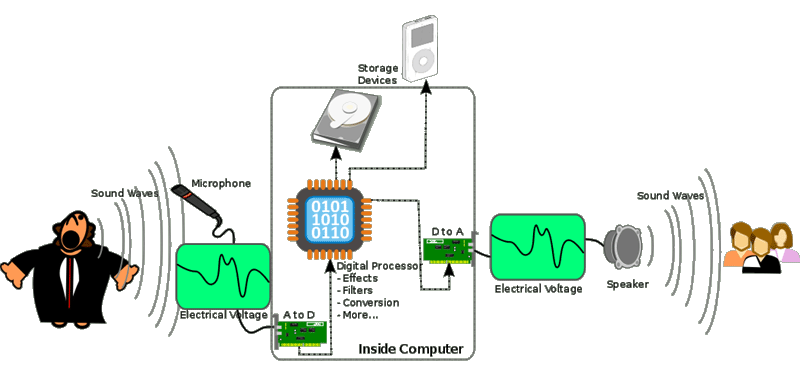

The Recording Signal
Path:
Microphone :
The first link in our recording chain
which converts sound wave energy into electrical
signal. The most common ones are Dynamic and Condenser.
Condenser microphones frequency range is wider and
require 48 volt dc 'phantom power' usually supplied
by mic pre amp or sound card.
DI Box :
A DI
box is used to convert a signal from one level and
impedance to another.Any
instrument
using a pick up ,piezo etc.with need their outputs
to be "matched" with the low impedance
input of the mixer’s mic preamp. A bass guitar
will not sound at its best if it is plugged straight
into the line input of a console but when using a
DI box will assure a full high resolution signal
with minimum degradation of sound quality.
Connectors :
Most professional mics use 3-pin
XLR connector which is connected to the microphone
and
plugs into the mic preamp input. This connector
uses balanced lines which greatly reduces noise and
can
provide the usage of longer cable lengths. So these
advantages make balanced lines the natural choice
for connecting Microphones and DI Boxes.
Microphone Pre
Amplifier & Gain
structure :
The Mic amp is one of the most important yet overlooked
links in the recording chain It’s a critical
component to the tone of your tracks.There are
basically 2 types of mic pre amps solid-state and
tube. Choosing between them is a matter of taste
and aesthetics. A good solid state design will
give you a clean transparent sound and the vacuum
tube will color it by adding some harmonic distortion
which many perceive as “warmth” In
any case you’ll want a preamp that provides
a detailed sound, and that has a wide dynamic range – enabling
you to turn the gain up on softer signals without
adding noise but also providing enough headroom
so a loud source won’t get instantly distorted.
A cheap mic preamp can sound dull, lifeless, and
will often distort your signals. Setting proper levels throughout the recording chain
will assure the signals are well recorded.
You need to get
healthy levels on your preamp,but with enough headroom
in case your sources get hotter.
One the other hand make sure your levels aren’t
too low Digital converters,software and plugins sound
better with a properly staged signal.and the more
of that dynamic range you use,the more accurate and
therefore, better-sounding, they will be. Proper
gain staging will reflect in the overall quality
of your tracks and mixes.
Avoiding Phase Cancellation
Signal Processing in
the Recording chain :
The most
common used processors in the recording chain are
compression/limiting and EQ. Compression/limiting
is often used to control the signal's ultra fast
peaks which would otherwise cause distortion.Any
processing that is applied however can not be undone,
so must be carefully applied.
A/D Convertors :
The conversion from an analog electrical
signal to a digital binary signal is usually the
last link in our recording chain. The converters
are usually on the audio interface .Like the preamp,
the A-D converters are an often overlooked part of
the recording chain. Although the symptoms of poor
A-D conversion can be subtle, there is a definite
degradation in the sound quality. Usually poor A-D
conversion is caused by inaccurate digital clocks
causing 'jitter” These can cause a 'blurred'
stereo image and unwanted noise.These deficiencies
cannot be rectified once has been converted to digital
so it is preferable to ensure that your A-D conversion
is as accurate as possible.


